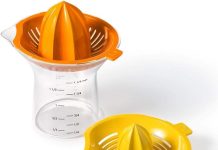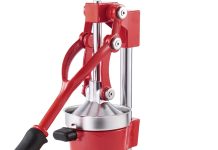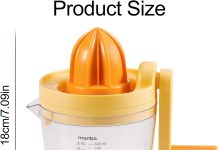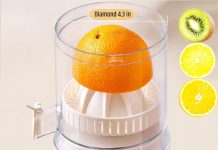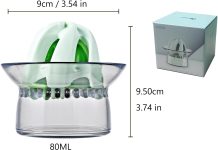Juice lovers, we’ve all been there – that disappointing moment when we pour ourselves a glass of refreshing juice, only to find that it has separated into a watery layer and a pulpy layer. But fear not, because we have uncovered some tried-and-true tips to keep your juice looking and tasting fresh. Whether you’re a fan of homemade juice or store-bought varieties, read on to discover the secrets of preventing that dreaded separation and enjoying a perfectly blended glass of juice every time.
Review contents
Understanding Juice Separation
What is juice separation?
Juice separation is the natural process in which the liquid and solid components of fruit or vegetable juice begin to separate over time. This can result in a layer of pulp or sediment settling at the bottom of the container, while the liquid portion becomes clearer and less opaque.
Why does juice separate?
Juice separation occurs due to the varying densities of the liquid and solid particles in the juice. Over time, the heavier particles, such as pulp, fiber, and solids, sink to the bottom, leaving the liquid portion on top. This separation is a result of gravity and can be influenced by several factors.
Common causes of juice separation
There are several common causes of juice separation. First and foremost, the type of fruit or vegetable used plays a significant role. Some fruits and vegetables naturally have a higher pulp content, making separation more likely. Temperature also plays a crucial role, as cooler temperatures facilitate separation. Improper storage conditions, such as exposure to air or extreme temperature changes, can also accelerate the process. Finally, the processing methods employed, including blending or juicing techniques, can impact the degree of separation as well.
Factors Affecting Juice Separation
Type of fruit or vegetable
The type of fruit or vegetable used in juice production is a crucial factor in determining the likelihood of separation. Fruits and vegetables with higher pulp content, such as oranges, apples, or carrots, are more prone to separation compared to smoother-textured varieties like grapes or cucumbers. Being aware of the nature of the specific produce being used can help anticipate and address potential separation issues.
Temperature
Temperature plays a significant role in juice separation. Cooler temperatures promote the settling of solids, leading to faster separation. It is important to note that different fruits and vegetables have different ideal storage temperatures. By storing the juice at the appropriate temperature, it is possible to delay or minimize the separation process.
Storage conditions
Proper storage conditions are vital in preventing juice separation. Exposure to air, particularly oxygen, can accelerate separation due to oxidation. Using airtight containers and consuming the juice within a short period of time can significantly reduce the chances of separation. Additionally, avoiding drastic temperature changes or fluctuations can help maintain the stability of the juice.
Processing methods
The processing methods used in juice production can also impact the degree of separation. Techniques such as using a blender or juicer that efficiently breaks down the fibers and solid particles can help distribute them more evenly throughout the juice, reducing the chances of separation. Careful selection of processing methods is essential to maintaining the desired consistency and preventing separation.
Preventing Juice Separation
Selecting the right fruit or vegetable
Choosing the right fruit or vegetable is the first step in preventing juice separation. Opting for varieties with lower pulp content can reduce the chances of separation. Smooth-textured fruits like berries or citrus fruits, as well as leafy greens like spinach or kale, tend to have less pulp, making them ideal choices for juice production.
Using a blender or juicer
Using a blender or juicer is another effective way to prevent juice separation. Both appliances help break down the cell walls of fruits and vegetables, ensuring a more homogenous juice mixture. The resulting blend of solids and liquid will be more evenly dispersed, reducing the tendency for separation to occur.
Controlling temperature
Controlling the temperature of the juice can significantly impact separation. Storing the juice at a refrigerated temperature can slow down the separation process by inhibiting the movement of the solid particles. It is important to note that excessively cold temperatures can affect the flavor and texture of the juice, so finding the optimal temperature is key.
Proper storage techniques
Proper storage techniques are crucial in preventing juice separation. Transferring the juice to airtight containers, such as glass bottles or jars, helps minimize exposure to air and slows down the oxidation process. Additionally, storing the juice in the refrigerator can provide a cool and stable environment, further reducing the chances of separation.
Choosing the appropriate processing method
Choosing the appropriate processing method is essential for preventing juice separation. Cold-pressed or slow juicing methods, which utilize hydraulic pressure to extract juice, result in minimal agitation and oxidation, preserving the natural integrity of the juice. This helps maintain the structure and prevents separation. Selecting the right equipment and process can make a significant difference in the final product.
Tips for Preventing Juice Separation
Add natural emulsifiers
Adding natural emulsifiers to the juice can help prevent separation. Emulsifiers act as stabilizing agents, helping to keep the liquid and solid particles suspended in the juice. Some examples of natural emulsifiers include lecithin, which can be found in soybeans or egg yolks, and pectin, which is naturally present in fruits like apples or citrus fruits. Incorporating these ingredients into the juice can enhance its stability and prevent separation.
Use additives or stabilizers
Additives or stabilizers can also be used to prevent juice separation. These substances work by binding to the liquid and solid components, preventing them from separating. Common additives and stabilizers include guar gum, xanthan gum, or carrageenan. While these ingredients are effective in maintaining the homogeneity of the juice, it is essential to use them in moderation to avoid altering the taste or texture of the final product.
Blending with whole fruits or vegetables
Blending the juice with whole fruits or vegetables can mitigate separation. By incorporating the fiber-rich pulp or flesh into the juice, the viscosity of the liquid increases, reducing the chances of separation. This method helps create a more visually appealing and palatable juice while also providing additional nutritional benefits.
Straining the juice
Straining the juice before consumption can also prevent separation. By removing any remaining solids or pulp, the juice becomes clearer and more visually pleasing. This can be achieved by using a fine-mesh strainer or cheesecloth to filter out any undesirable particles. While straining removes some fiber, it can help maintain the desired consistency and prevent separation.
Stirring or shaking the juice
Regularly stirring or shaking the juice can help prevent separation. This action helps distribute the solid particles more evenly throughout the liquid, reducing the likelihood of settling. By shaking or stirring the juice before consumption, you can achieve a more uniform texture and minimize separation.
Avoiding exposure to air
Exposure to air can accelerate the oxidation process, leading to separation. To prevent this, it is important to minimize the juice’s contact with air. Using airtight containers, filling the containers to the brim to reduce surface area, and avoiding unnecessary opening or transfer of the juice can all contribute to preserving its integrity and preventing separation.
Avoiding drastic temperature changes
Drastic temperature changes can also contribute to juice separation. Sudden shifts from hot to cold or vice versa can disrupt the stability of the juice, causing separation. To prevent this, it is important to avoid exposing the juice to extreme temperature changes. Gradual transitions and careful temperature control can help maintain the desired consistency and prevent separation.
Using cold-pressed or slow juicing methods
Opting for cold-pressed or slow juicing methods can help prevent separation. These methods extract juice without generating excessive heat or agitation, preserving the natural integrity of the juice. The resulting juice tends to have a smoother texture and is less prone to separation. Investing in a juicer or seeking out cold-pressed options can help ensure a more stable juice with minimal separation.
Avoiding excessive processing
Excessive processing can lead to juice separation. Overworking the juice through aggressive blending or juicing techniques can disrupt the natural balance of the liquid and solid particles, increasing the chances of separation. Taking a more gentle approach and avoiding excessive processing can help maintain the desired consistency and prevent separation.
Using juicers with pulp regulators
Using juicers with pulp regulators can prevent separation. These juicers allow you to adjust the amount of pulp or fiber in the juice. By incorporating some of the solid particles into the juice, you help maintain a more homogeneous mixture, reducing separation. Choosing a juicer with this feature can provide greater control over the final product and prevent separation.
Alternative Techniques for Preventing Juice Separation
Homogenization
Homogenization is an alternative technique for preventing juice separation. This process involves subjecting the juice to high pressure, which breaks down the solid particles and creates a more uniform mixture. Homogenization disrupts the fat globules and fibrils in the juice, preventing them from recombining and causing separation. However, it is important to note that this technique requires specialized equipment and may not be practical for home use.
Homemade emulsifiers
Creating homemade emulsifiers can be an effective way to prevent juice separation. Ingredients like honey, mustard, or certain herbs like mint or basil can act as natural emulsifiers. These substances help stabilize the juice by creating a colloidal suspension, preventing the solid particles from settling. Experimenting with different homemade emulsifiers can be a fun and creative way to prevent separation.
Vacuum sealing
Vacuum sealing is a technique commonly used in commercial juice production to prevent separation. By removing the air from the container, vacuum sealing creates a low-oxygen environment, reducing oxidation and minimizing separation. This method can be replicated at home using vacuum sealers or specialized containers designed for this purpose.
High-pressure processing
High-pressure processing is an innovative technique that can prevent juice separation. This method involves subjecting the juice to high levels of hydrostatic pressure, which inactivates enzymes and delays spoilage. High-pressure processing helps maintain the homogeneity of the juice by preventing the separation of solid particles. While this technique is primarily used in commercial settings, there are emerging home appliances that utilize high-pressure processing as well.
Chemical stabilizers
Chemical stabilizers are another alternative for preventing juice separation. These substances, such as polyphosphates or sodium alginate, help bind the particles together, preventing them from settling. While chemical stabilizers can be effective, it is important to consider the potential impact on taste and texture. Careful experimentation and moderation are necessary when using chemical stabilizers to prevent separation.
How to Store Juice to Prevent Separation
Choosing the right container
Choosing the right container is vital in preventing juice separation during storage. Airtight containers, such as glass bottles or jars, are ideal for minimizing exposure to air and reducing oxidation. Additionally, opting for containers with tight-fitting lids or seals can help maintain the integrity of the juice and prevent separation.
Refrigeration
Refrigeration is a tried and true method for preventing juice separation. Storing the juice in the refrigerator helps maintain a cool and stable environment, slowing down the movement of solid particles and delaying separation. It is important to note that different fruits and vegetables have varying ideal storage temperatures, so finding the optimal refrigeration temperature is key to preventing separation.
Freezing
Freezing can also prevent juice separation. By lowering the temperature, freezing inhibits the movement of the solid particles, keeping them suspended throughout the juice. However, it is essential to take note of the expansion that occurs during freezing, leaving adequate headspace in the container to avoid leakage or breakage. Thawing the frozen juice should be done gradually to prevent separation upon thawing.
Using glass bottles or jars
Using glass bottles or jars is preferable when storing juice to prevent separation. Glass containers provide an airtight seal and are less prone to chemical reactions compared to plastic or metal containers. Glass also helps maintain the freshness and flavors of the juice. It is important to ensure that the jars or bottles are clean and sterilized before use to avoid contamination.
Avoiding exposure to light
Exposure to light can contribute to juice separation, as it can accelerate oxidation. To prevent this, it is important to store the juice in opaque or dark-colored containers that block out light. This helps preserve the color, flavor, and nutritional integrity of the juice, reducing the likelihood of separation.
Effects of Juice Separation on Flavor and Nutrients
Flavor changes
Juice separation can result in flavor changes. The liquid portion that remains on top after separation may have a different taste compared to the initially homogenous juice. This is because certain flavors, aromas, and volatile compounds may be concentrated in the liquid or remain predominantly in the settled solids. By preventing separation, you can ensure a more consistent and enjoyable flavor profile.
Nutritional impact
Juice separation can also have an impact on the nutritional composition of the juice. The separation process may cause certain nutrients, such as vitamins or antioxidants, to become more concentrated in either the liquid or solid phase. By consuming freshly made juice without separation, you can maximize your intake of these valuable nutrients. Additionally, consuming a more uniform juice allows for a more balanced nutritional profile.
Importance of consuming freshly made juice
Consuming freshly made juice is vital to experience the full benefits and flavors of the juice. Freshly made juice not only minimizes the chances of separation but also ensures the highest nutritional content and optimal freshness. By regularly consuming freshly made juice, you can enjoy the best taste, health benefits, and overall quality that juice has to offer.
Troubleshooting Juice Separation Issues
Understanding common problems
To troubleshoot juice separation issues, it is essential to understand the common problems that can lead to separation. Factors such as improper storage techniques, temperature fluctuations, excessive processing, or using the wrong fruit or vegetable are typically the primary causes of separation. Identifying the root cause of the separation can help determine the appropriate course of action.
Solutions for re-emulsifying separated juice
If juice separation has occurred, there are solutions to re-emulsify the separated juice. One method is to vigorously shake or stir the juice to redistribute the solid particles. This can help temporarily suspend the solids in the liquid. Another solution is to blend the separated juice again using a blender or juicer to remix the components. If the separation is minimal, simply pouring the juice through a fine-mesh strainer can help achieve a more visually appealing liquid, albeit with some loss of the solids.
Preventing future separation
To prevent future separation, it is important to address the underlying causes. This includes selecting the right fruit or vegetable, using appropriate processing methods, controlling temperature, and employing proper storage techniques. By proactively implementing preventive measures, you can minimize the chances of separation and enjoy a more consistent and visually appealing juice.
Innovations in Juice Processing and Packaging
Emerging technologies
The field of juice processing and packaging continues to evolve, with emerging technologies aimed at preventing juice separation. High-pressure processing, ultrasound technology, and new emulsification techniques are being developed to enhance the stability and quality of juice. These innovations focus on minimizing oxidation, preserving flavors, and preventing separation, ultimately providing consumers with a more satisfactory juice experience.
Advanced packaging solutions
Advanced packaging solutions are also being developed to prevent separation and extend the shelf life of juice. These solutions include vacuum-sealed pouches, modified atmosphere packaging, or specialized caps and closures that minimize air exposure. By incorporating these advanced packaging solutions, juice producers can improve the shelf stability and visual appeal of their products, ensuring a more enjoyable drinking experience for consumers.
Conclusion
Understanding the process of juice separation and knowing how to prevent it is essential for maintaining the quality and appeal of fruit and vegetable juices. By considering factors such as the type of produce, temperature, storage conditions, and processing methods, it is possible to prevent or minimize juice separation. Implementing techniques such as using emulsifiers, appropriate processing equipment, and suitable storage containers can greatly enhance juice stability. By following these tips, you can enjoy visually appealing, flavorful, and nutritious juices without the frustration of separation. As innovations continue to emerge in juice processing and packaging, the industry is poised to deliver even more stable and visually appealing juices to meet the evolving demands of consumers.



